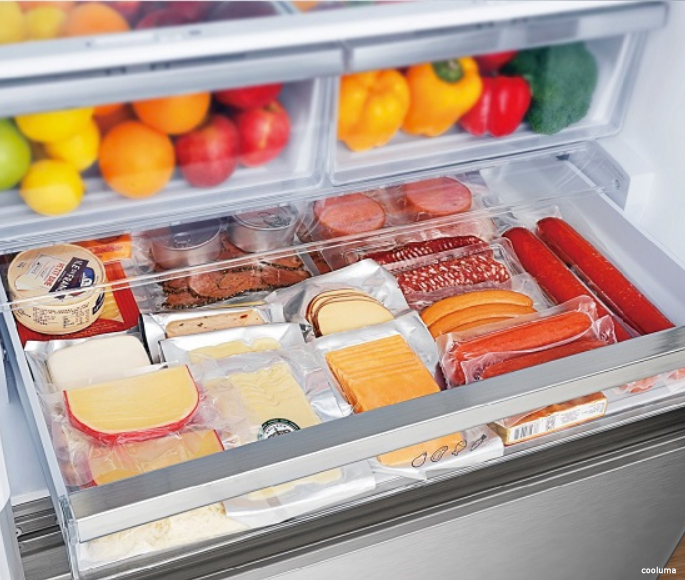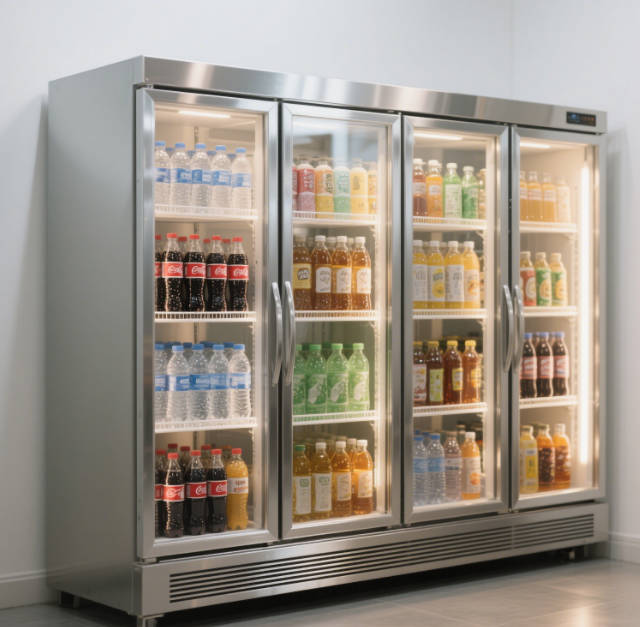
The production of commercial cake display cabinets requires designing line drawings, using professional software to draw dimension diagrams, the factory processing various components according to the drawings, and finally assembling and testing. Of course, there are many factors that can affect the quality of production.
Stainless Steel Grade: Using food-grade 304 stainless steel (vs. lower-grade 201) directly impacts corrosion resistance and longevity. Inferior steel may rust from frequent cleaning or humidity, compromising structural integrity.
Glass Specifications: Tempered glass thickness (4-6mm) and anti-fog coatings determine durability and visibility. Poorly processed glass may shatter or develop condensation issues, reducing display functionality.
Insulation Materials: High-density PU foam (density ≥40 kg/m³) ensures thermal efficiency. Low-quality foam with uneven expansion leads to temperature fluctuations and energy waste.
1. Refrigeration System Components
Compressor Performance: Reliable hermetic compressors (1/4 to 1/2 HP) with inverter technology maintain stable temperatures. Substandard compressors cause frequent breakdowns and inconsistent cooling (±1°C precision is critical).
Copper Tubing and Sealing: Leak-proof brazing of refrigerant lines (using R134a or R600a) prevents coolant loss. Poorly sealed joints lead to reduced cooling capacity and environmental hazards.
Evaporator and Fan Design: Finned evaporators and variable-speed fans ensure uniform airflow. Inadequate airflow design results in hot spots (exceeding 10°C) that spoil cakes.
2. Manufacturing Precision and Craftsmanship
Welding and Assembly: Smooth, seamless welds on the frame prevent bacteria buildup and structural weak points. Rough seams or loose rivets cause air leakage and reduce insulation efficiency.
Door Seal Integrity: High-quality gaskets on glass doors (or air curtains for open models) must create an airtight seal. Misaligned doors or worn gaskets allow cold air escape, increasing energy use by 10-15%.
Shelving Stability: Reinforced brackets supporting 15-20kg per shelf prevent sagging. Flimsy shelving risks product damage and safety hazards.
3. Design Engineering and Testing
Airflow Simulation: 3D modeling of airflow patterns ensures consistent temperature/humidity (60-75% RH). Poorly designed airflow leads to moisture imbalances, causing cake drying or mold growth.
Humidity Control Calibration: Accurate sensors and humidifiers (for closed models) must maintain precise RH levels. Faulty calibration results in glaze cracking or texture degradation of baked goods.
Performance Testing: 24-hour temperature stability tests (with multi-point sensors) and pressure checks for refrigerant leaks are mandatory. Skipping these steps leads to post-installation failures.
4. Compliance with Industry Standards
Food Safety Certifications: Adherence to FDA, EU 10/2011, or NSF standards ensures materials are non-toxic and easy to sanitize. Non-compliant components may leach chemicals into food.
Energy Efficiency Regulations: Meeting EU Ecodesign or US DOE standards requires optimized insulation and inverter technology. Non-compliant units face higher operational costs and market restrictions.
Safety Compliance: Electrical components (wiring, controllers) must pass IEC 60335 or UL 471 tests. Faulty electrical systems pose fire risks in commercial settings.
6. Aesthetic and Functional Balance
Lighting Integration: LED strips (3000K warm white) with diffusers prevent glare and heat buildup. Poorly placed lighting creates shadows or uneven illumination, undermining display purposes.
Ergonomic Design: Adjustable shelving and door hinges (supporting 100,000+ openings) enhance usability. Stiff hinges or fixed shelves reduce practicality in high-traffic environments.
These factors collectively determine a cake display cabinet’s ability to preserve food quality, withstand commercial use, and meet operational demands—ultimately defining its long-term performance and reliability.






This batch of products seems to be of good quality.